Comprehensive Analysis: First Aid Management of Medical Emergencies
VerifiedAdded on 2024/06/05
|17
|2765
|165
Report
AI Summary
This report provides a comprehensive overview of first aid procedures for various medical emergencies. It details the roles and responsibilities of a first aider, including assessing emergencies, providing immediate care, and ensuring safety. The report covers specific emergency scenarios such as epileptic seizures, anaphylactic shock, cuts, bruises, burns, and severe bleeding, outlining appropriate treatments and first aid measures. It includes an accident report example, descriptions of essential first aid items and emergency drugs, and modifications for administering CPR to children and babies. The document also addresses risks during medical emergencies and methods for minimizing them, along with charts detailing treatments for conditions like hypoglycemia, heart attack, and cardiac arrest. The report concludes with a reference list, emphasizing its role as a guide for effective emergency response.
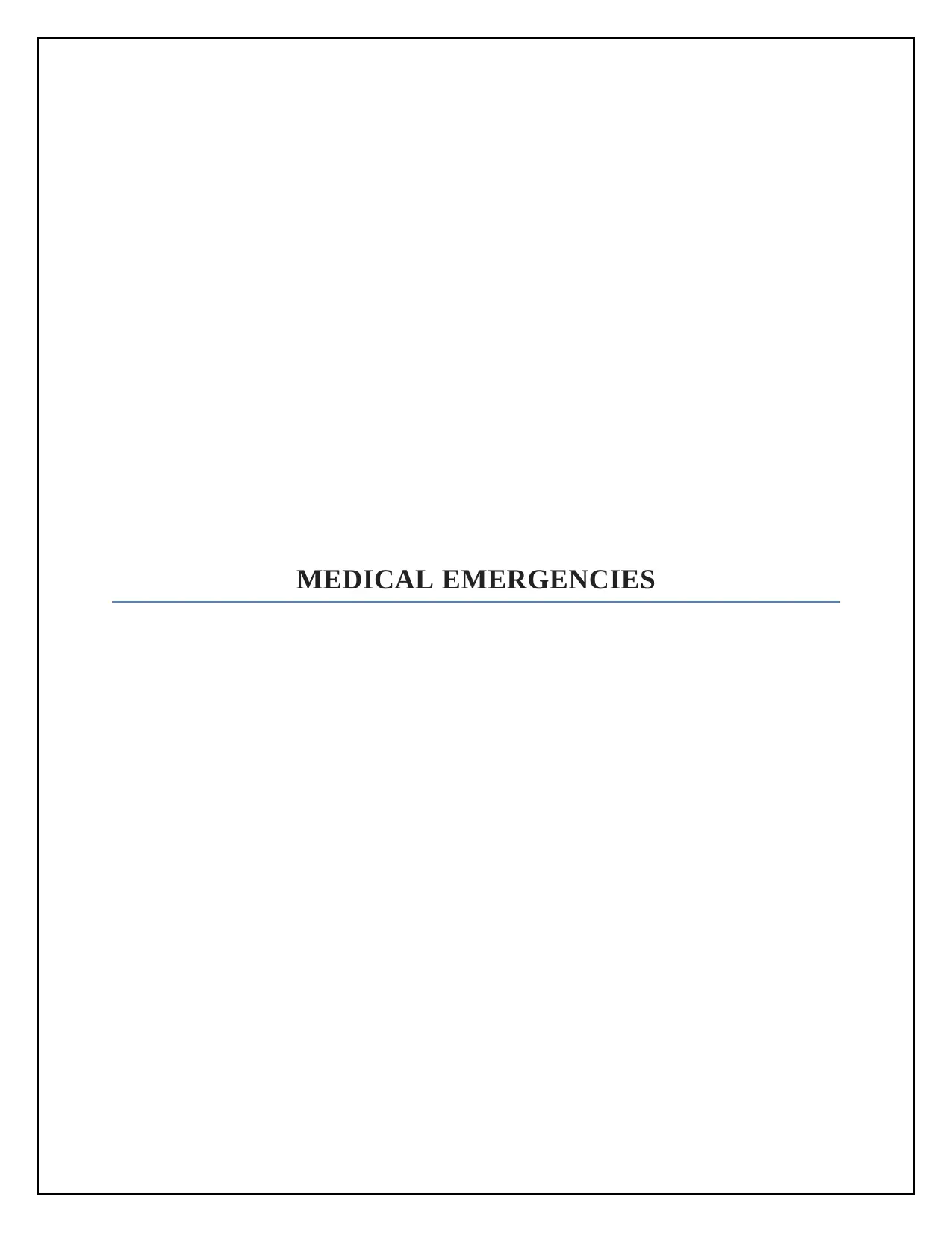
MEDICAL EMERGENCIES
Paraphrase This Document
Need a fresh take? Get an instant paraphrase of this document with our AI Paraphraser
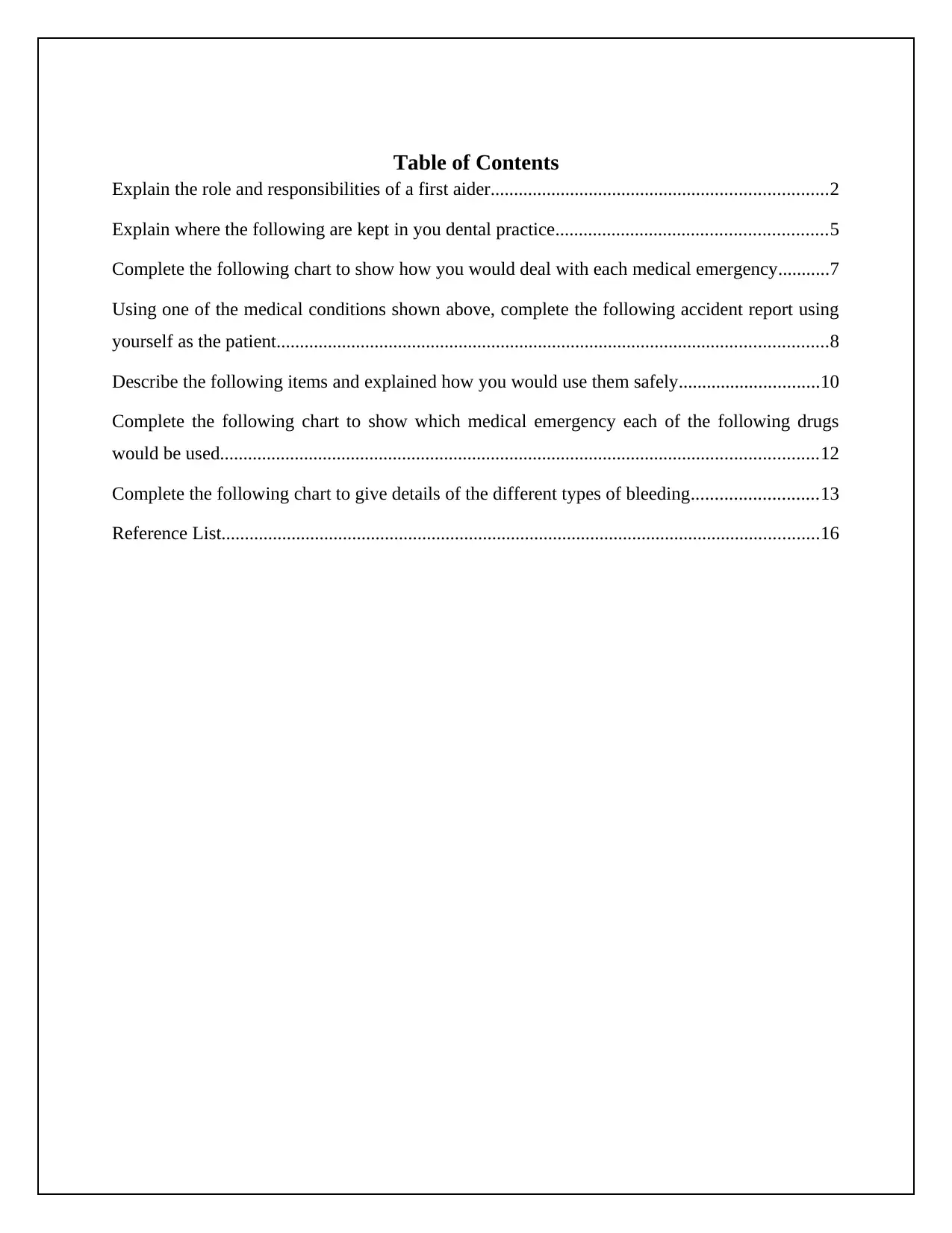
Table of Contents
Explain the role and responsibilities of a first aider........................................................................2
Explain where the following are kept in you dental practice..........................................................5
Complete the following chart to show how you would deal with each medical emergency...........7
Using one of the medical conditions shown above, complete the following accident report using
yourself as the patient......................................................................................................................8
Describe the following items and explained how you would use them safely..............................10
Complete the following chart to show which medical emergency each of the following drugs
would be used................................................................................................................................12
Complete the following chart to give details of the different types of bleeding...........................13
Reference List................................................................................................................................16
Explain the role and responsibilities of a first aider........................................................................2
Explain where the following are kept in you dental practice..........................................................5
Complete the following chart to show how you would deal with each medical emergency...........7
Using one of the medical conditions shown above, complete the following accident report using
yourself as the patient......................................................................................................................8
Describe the following items and explained how you would use them safely..............................10
Complete the following chart to show which medical emergency each of the following drugs
would be used................................................................................................................................12
Complete the following chart to give details of the different types of bleeding...........................13
Reference List................................................................................................................................16
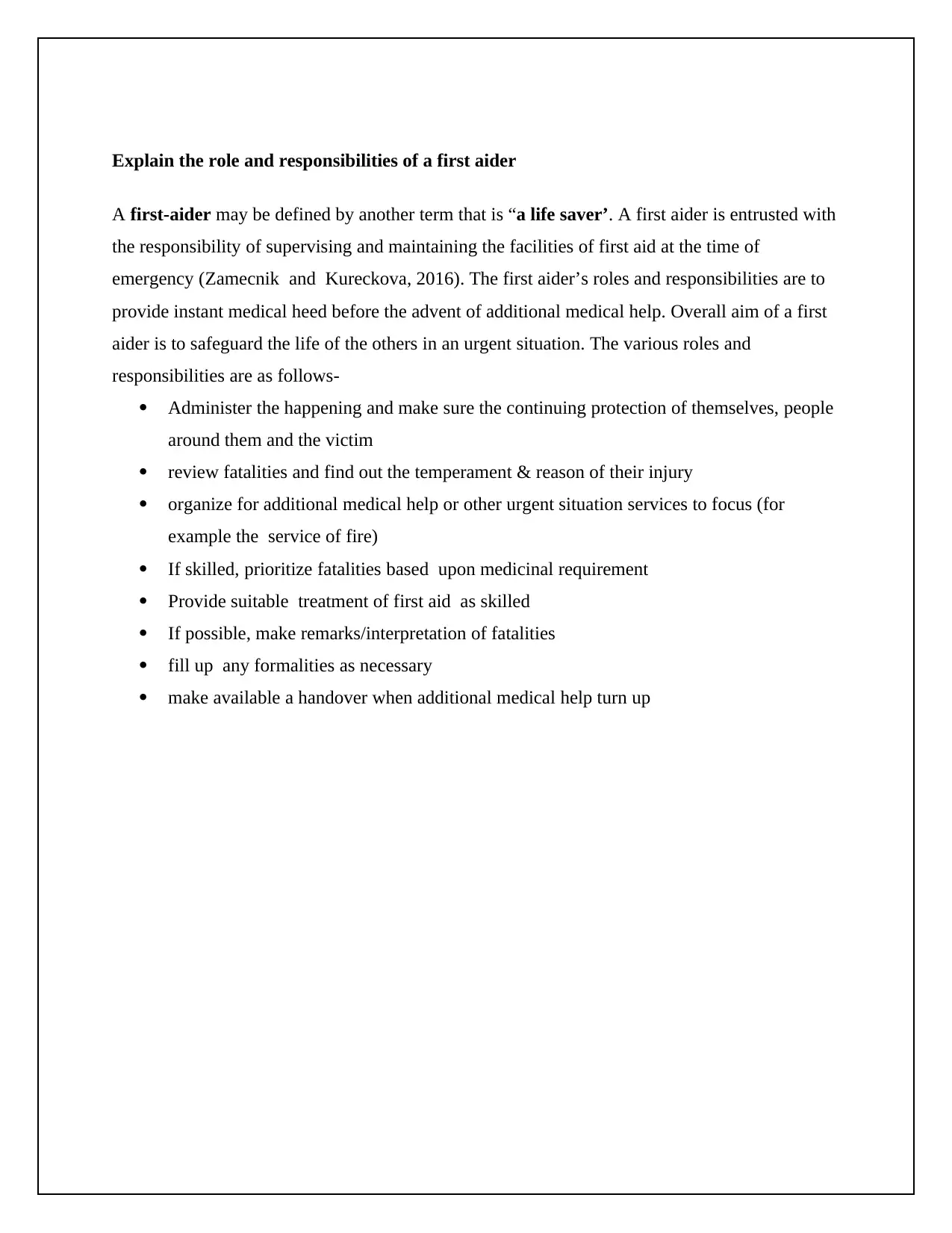
Explain the role and responsibilities of a first aider
A first-aider may be defined by another term that is “a life saver’. A first aider is entrusted with
the responsibility of supervising and maintaining the facilities of first aid at the time of
emergency (Zamecnik and Kureckova, 2016). The first aider’s roles and responsibilities are to
provide instant medical heed before the advent of additional medical help. Overall aim of a first
aider is to safeguard the life of the others in an urgent situation. The various roles and
responsibilities are as follows-
Administer the happening and make sure the continuing protection of themselves, people
around them and the victim
review fatalities and find out the temperament & reason of their injury
organize for additional medical help or other urgent situation services to focus (for
example the service of fire)
If skilled, prioritize fatalities based upon medicinal requirement
Provide suitable treatment of first aid as skilled
If possible, make remarks/interpretation of fatalities
fill up any formalities as necessary
make available a handover when additional medical help turn up
A first-aider may be defined by another term that is “a life saver’. A first aider is entrusted with
the responsibility of supervising and maintaining the facilities of first aid at the time of
emergency (Zamecnik and Kureckova, 2016). The first aider’s roles and responsibilities are to
provide instant medical heed before the advent of additional medical help. Overall aim of a first
aider is to safeguard the life of the others in an urgent situation. The various roles and
responsibilities are as follows-
Administer the happening and make sure the continuing protection of themselves, people
around them and the victim
review fatalities and find out the temperament & reason of their injury
organize for additional medical help or other urgent situation services to focus (for
example the service of fire)
If skilled, prioritize fatalities based upon medicinal requirement
Provide suitable treatment of first aid as skilled
If possible, make remarks/interpretation of fatalities
fill up any formalities as necessary
make available a handover when additional medical help turn up
⊘ This is a preview!⊘
Do you want full access?
Subscribe today to unlock all pages.

Trusted by 1+ million students worldwide
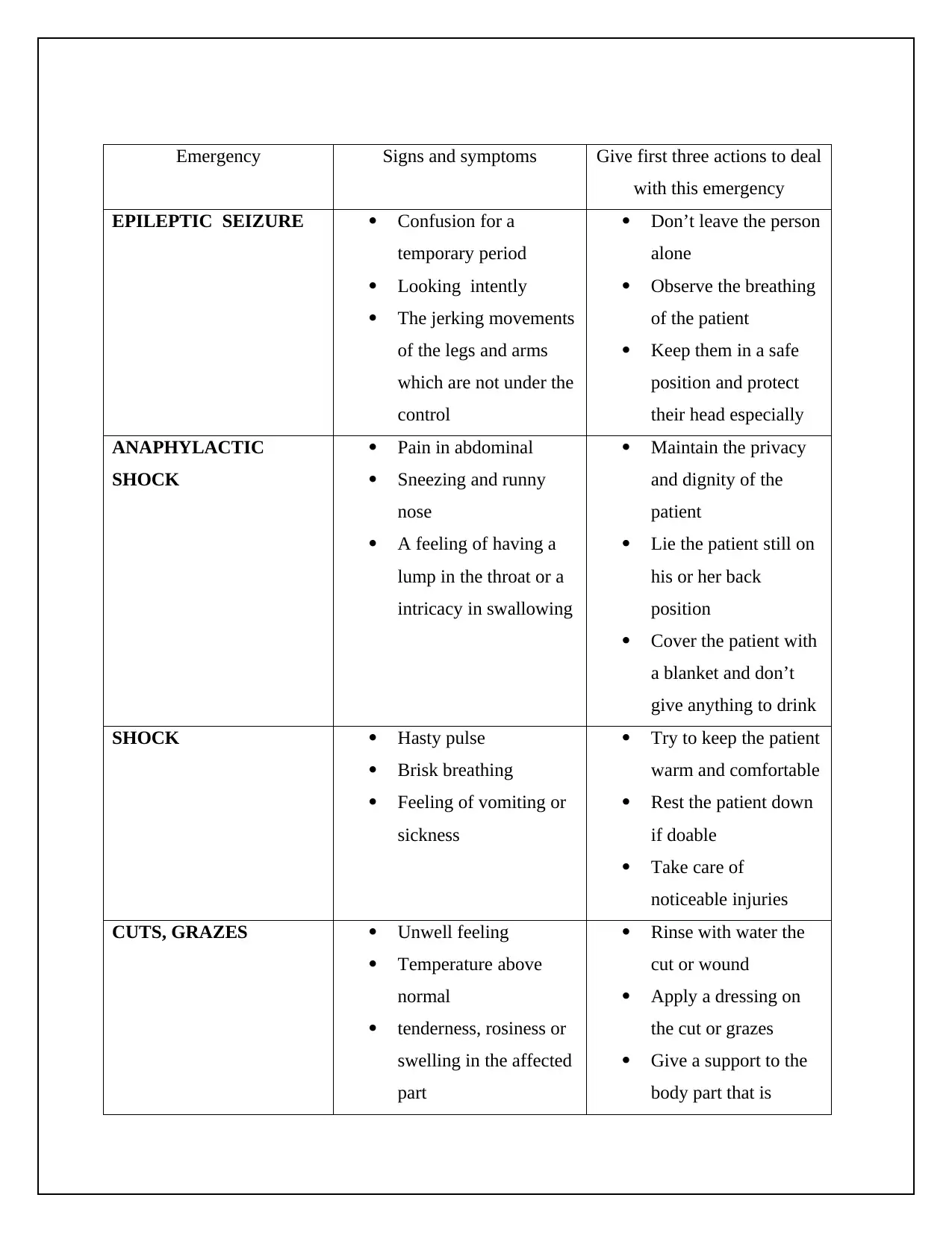
Emergency Signs and symptoms Give first three actions to deal
with this emergency
EPILEPTIC SEIZURE Confusion for a
temporary period
Looking intently
The jerking movements
of the legs and arms
which are not under the
control
Don’t leave the person
alone
Observe the breathing
of the patient
Keep them in a safe
position and protect
their head especially
ANAPHYLACTIC
SHOCK
Pain in abdominal
Sneezing and runny
nose
A feeling of having a
lump in the throat or a
intricacy in swallowing
Maintain the privacy
and dignity of the
patient
Lie the patient still on
his or her back
position
Cover the patient with
a blanket and don’t
give anything to drink
SHOCK Hasty pulse
Brisk breathing
Feeling of vomiting or
sickness
Try to keep the patient
warm and comfortable
Rest the patient down
if doable
Take care of
noticeable injuries
CUTS, GRAZES Unwell feeling
Temperature above
normal
tenderness, rosiness or
swelling in the affected
part
Rinse with water the
cut or wound
Apply a dressing on
the cut or grazes
Give a support to the
body part that is
with this emergency
EPILEPTIC SEIZURE Confusion for a
temporary period
Looking intently
The jerking movements
of the legs and arms
which are not under the
control
Don’t leave the person
alone
Observe the breathing
of the patient
Keep them in a safe
position and protect
their head especially
ANAPHYLACTIC
SHOCK
Pain in abdominal
Sneezing and runny
nose
A feeling of having a
lump in the throat or a
intricacy in swallowing
Maintain the privacy
and dignity of the
patient
Lie the patient still on
his or her back
position
Cover the patient with
a blanket and don’t
give anything to drink
SHOCK Hasty pulse
Brisk breathing
Feeling of vomiting or
sickness
Try to keep the patient
warm and comfortable
Rest the patient down
if doable
Take care of
noticeable injuries
CUTS, GRAZES Unwell feeling
Temperature above
normal
tenderness, rosiness or
swelling in the affected
part
Rinse with water the
cut or wound
Apply a dressing on
the cut or grazes
Give a support to the
body part that is
Paraphrase This Document
Need a fresh take? Get an instant paraphrase of this document with our AI Paraphraser
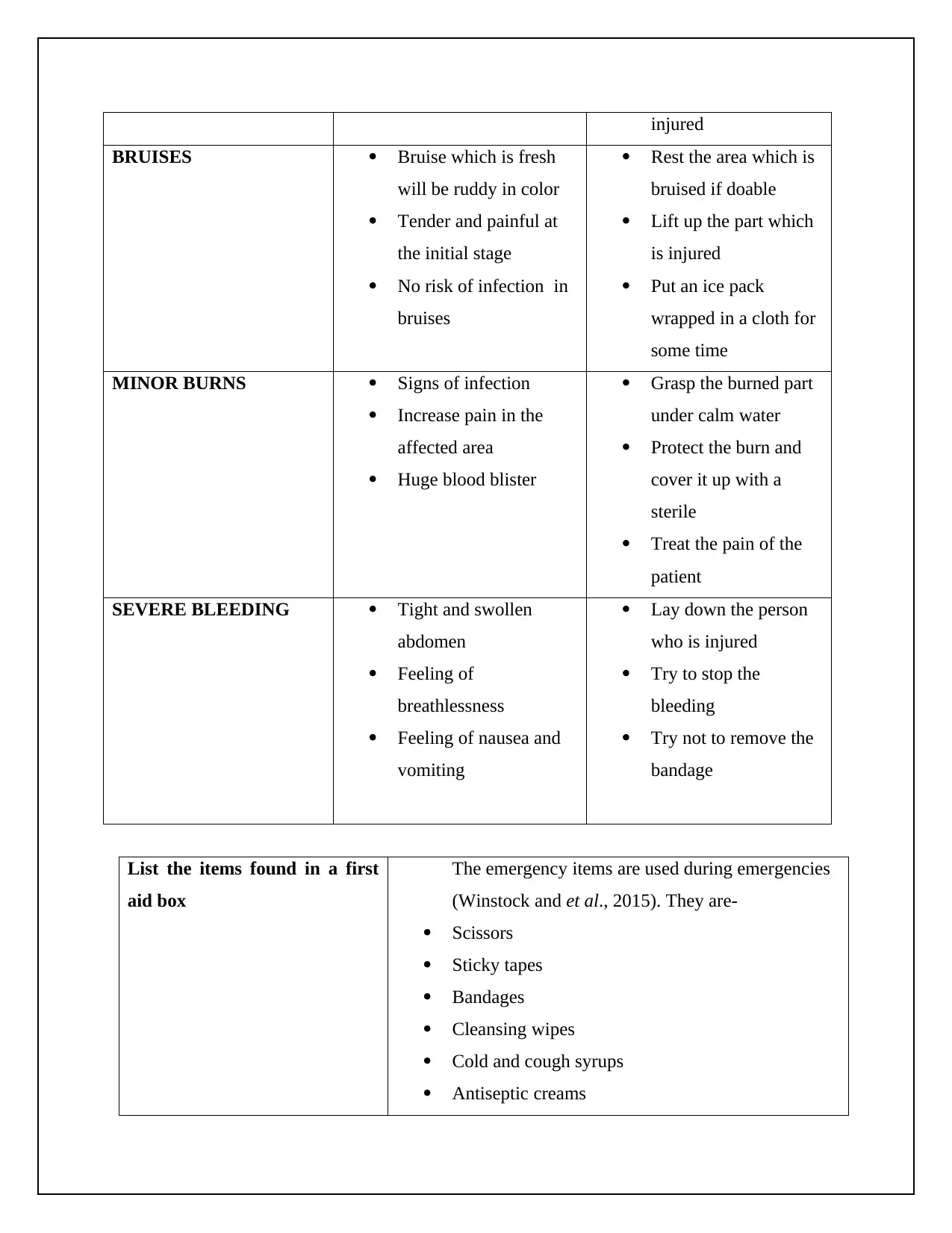
injured
BRUISES Bruise which is fresh
will be ruddy in color
Tender and painful at
the initial stage
No risk of infection in
bruises
Rest the area which is
bruised if doable
Lift up the part which
is injured
Put an ice pack
wrapped in a cloth for
some time
MINOR BURNS Signs of infection
Increase pain in the
affected area
Huge blood blister
Grasp the burned part
under calm water
Protect the burn and
cover it up with a
sterile
Treat the pain of the
patient
SEVERE BLEEDING Tight and swollen
abdomen
Feeling of
breathlessness
Feeling of nausea and
vomiting
Lay down the person
who is injured
Try to stop the
bleeding
Try not to remove the
bandage
List the items found in a first
aid box
The emergency items are used during emergencies
(Winstock and et al., 2015). They are-
Scissors
Sticky tapes
Bandages
Cleansing wipes
Cold and cough syrups
Antiseptic creams
BRUISES Bruise which is fresh
will be ruddy in color
Tender and painful at
the initial stage
No risk of infection in
bruises
Rest the area which is
bruised if doable
Lift up the part which
is injured
Put an ice pack
wrapped in a cloth for
some time
MINOR BURNS Signs of infection
Increase pain in the
affected area
Huge blood blister
Grasp the burned part
under calm water
Protect the burn and
cover it up with a
sterile
Treat the pain of the
patient
SEVERE BLEEDING Tight and swollen
abdomen
Feeling of
breathlessness
Feeling of nausea and
vomiting
Lay down the person
who is injured
Try to stop the
bleeding
Try not to remove the
bandage
List the items found in a first
aid box
The emergency items are used during emergencies
(Winstock and et al., 2015). They are-
Scissors
Sticky tapes
Bandages
Cleansing wipes
Cold and cough syrups
Antiseptic creams
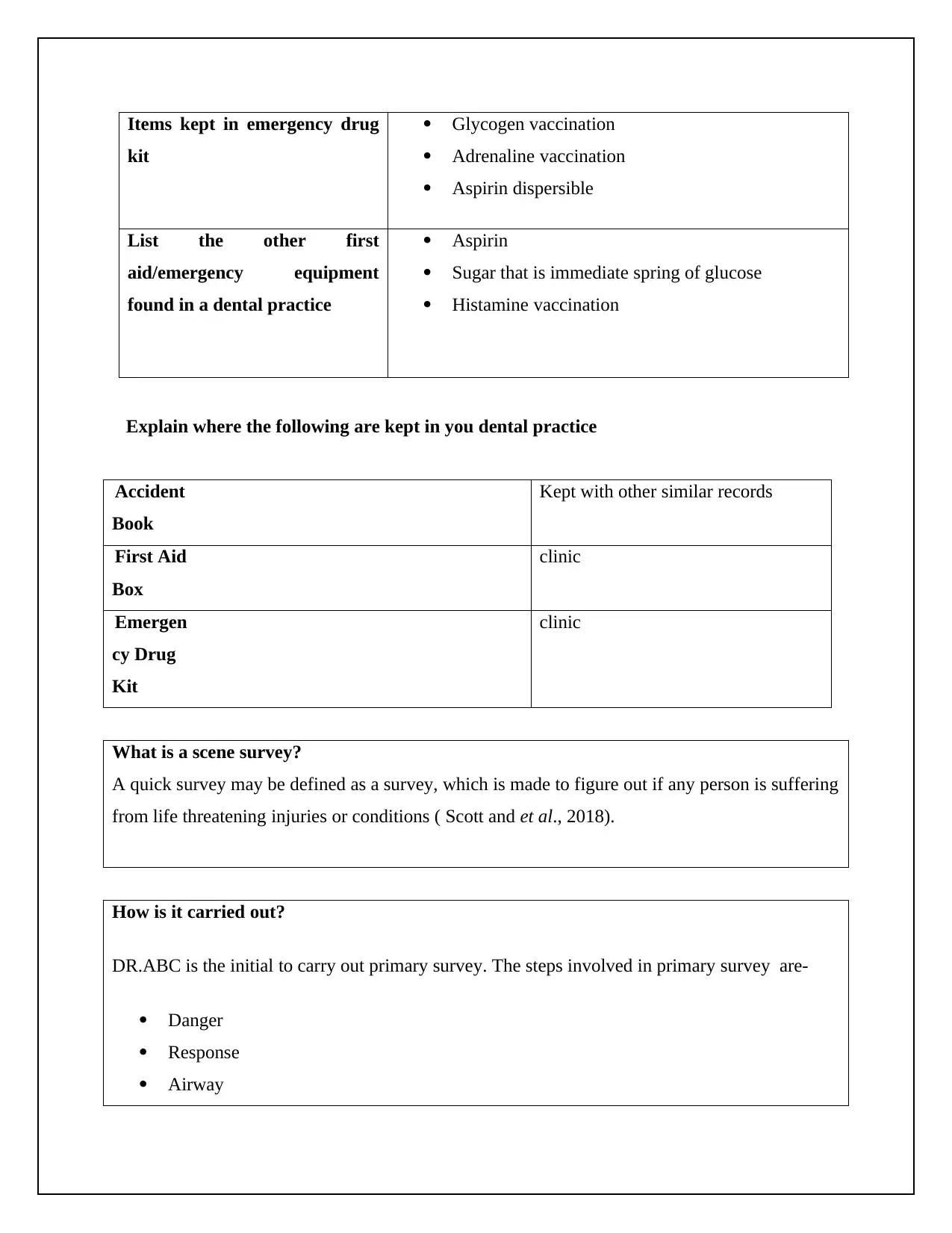
Items kept in emergency drug
kit
Glycogen vaccination
Adrenaline vaccination
Aspirin dispersible
List the other first
aid/emergency equipment
found in a dental practice
Aspirin
Sugar that is immediate spring of glucose
Histamine vaccination
Explain where the following are kept in you dental practice
Accident
Book
Kept with other similar records
First Aid
Box
clinic
Emergen
cy Drug
Kit
clinic
What is a scene survey?
A quick survey may be defined as a survey, which is made to figure out if any person is suffering
from life threatening injuries or conditions ( Scott and et al., 2018).
How is it carried out?
DR.ABC is the initial to carry out primary survey. The steps involved in primary survey are-
Danger
Response
Airway
kit
Glycogen vaccination
Adrenaline vaccination
Aspirin dispersible
List the other first
aid/emergency equipment
found in a dental practice
Aspirin
Sugar that is immediate spring of glucose
Histamine vaccination
Explain where the following are kept in you dental practice
Accident
Book
Kept with other similar records
First Aid
Box
clinic
Emergen
cy Drug
Kit
clinic
What is a scene survey?
A quick survey may be defined as a survey, which is made to figure out if any person is suffering
from life threatening injuries or conditions ( Scott and et al., 2018).
How is it carried out?
DR.ABC is the initial to carry out primary survey. The steps involved in primary survey are-
Danger
Response
Airway
⊘ This is a preview!⊘
Do you want full access?
Subscribe today to unlock all pages.

Trusted by 1+ million students worldwide
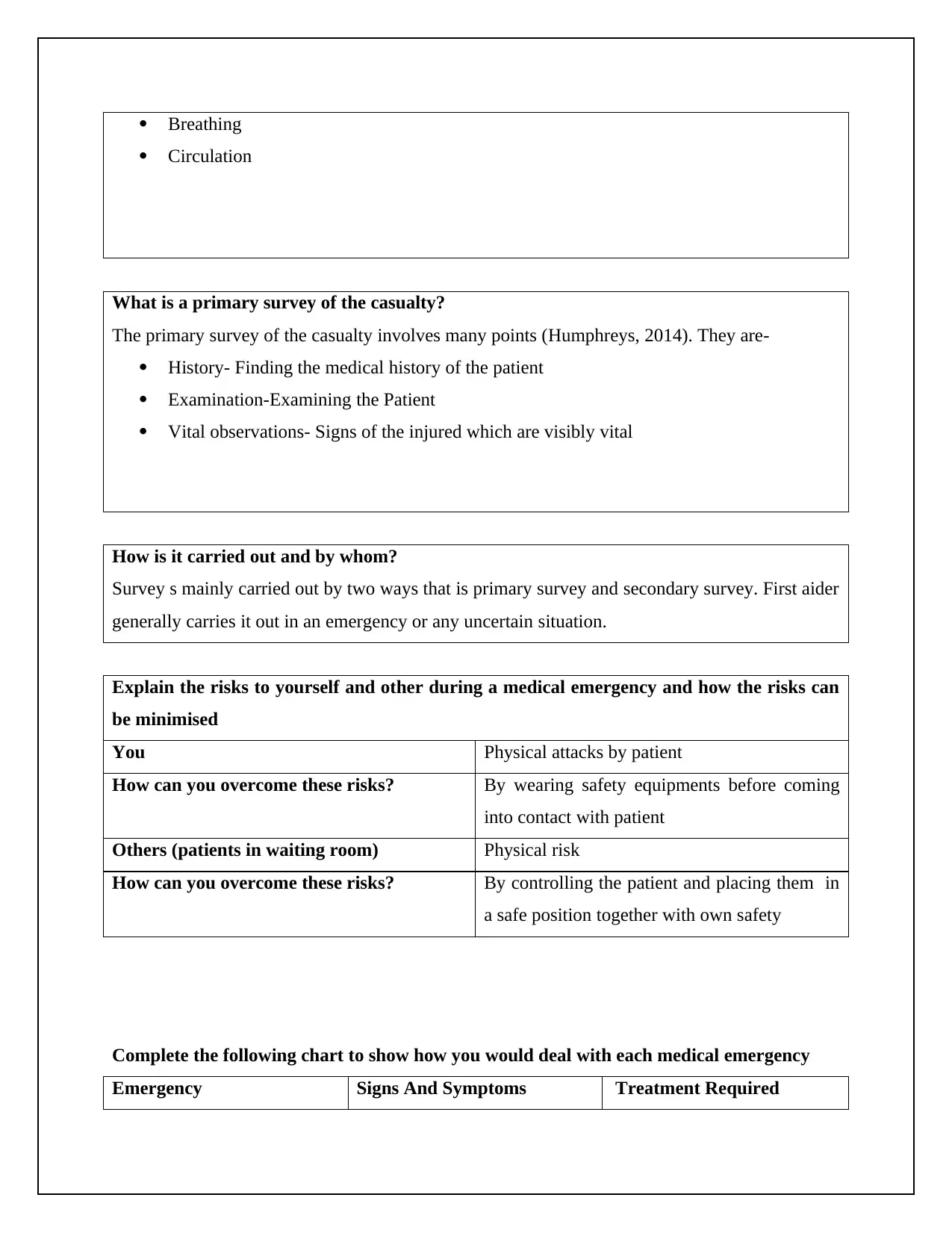
Breathing
Circulation
What is a primary survey of the casualty?
The primary survey of the casualty involves many points (Humphreys, 2014). They are-
History- Finding the medical history of the patient
Examination-Examining the Patient
Vital observations- Signs of the injured which are visibly vital
How is it carried out and by whom?
Survey s mainly carried out by two ways that is primary survey and secondary survey. First aider
generally carries it out in an emergency or any uncertain situation.
Explain the risks to yourself and other during a medical emergency and how the risks can
be minimised
You Physical attacks by patient
How can you overcome these risks? By wearing safety equipments before coming
into contact with patient
Others (patients in waiting room) Physical risk
How can you overcome these risks? By controlling the patient and placing them in
a safe position together with own safety
Complete the following chart to show how you would deal with each medical emergency
Emergency Signs And Symptoms Treatment Required
Circulation
What is a primary survey of the casualty?
The primary survey of the casualty involves many points (Humphreys, 2014). They are-
History- Finding the medical history of the patient
Examination-Examining the Patient
Vital observations- Signs of the injured which are visibly vital
How is it carried out and by whom?
Survey s mainly carried out by two ways that is primary survey and secondary survey. First aider
generally carries it out in an emergency or any uncertain situation.
Explain the risks to yourself and other during a medical emergency and how the risks can
be minimised
You Physical attacks by patient
How can you overcome these risks? By wearing safety equipments before coming
into contact with patient
Others (patients in waiting room) Physical risk
How can you overcome these risks? By controlling the patient and placing them in
a safe position together with own safety
Complete the following chart to show how you would deal with each medical emergency
Emergency Signs And Symptoms Treatment Required
Paraphrase This Document
Need a fresh take? Get an instant paraphrase of this document with our AI Paraphraser
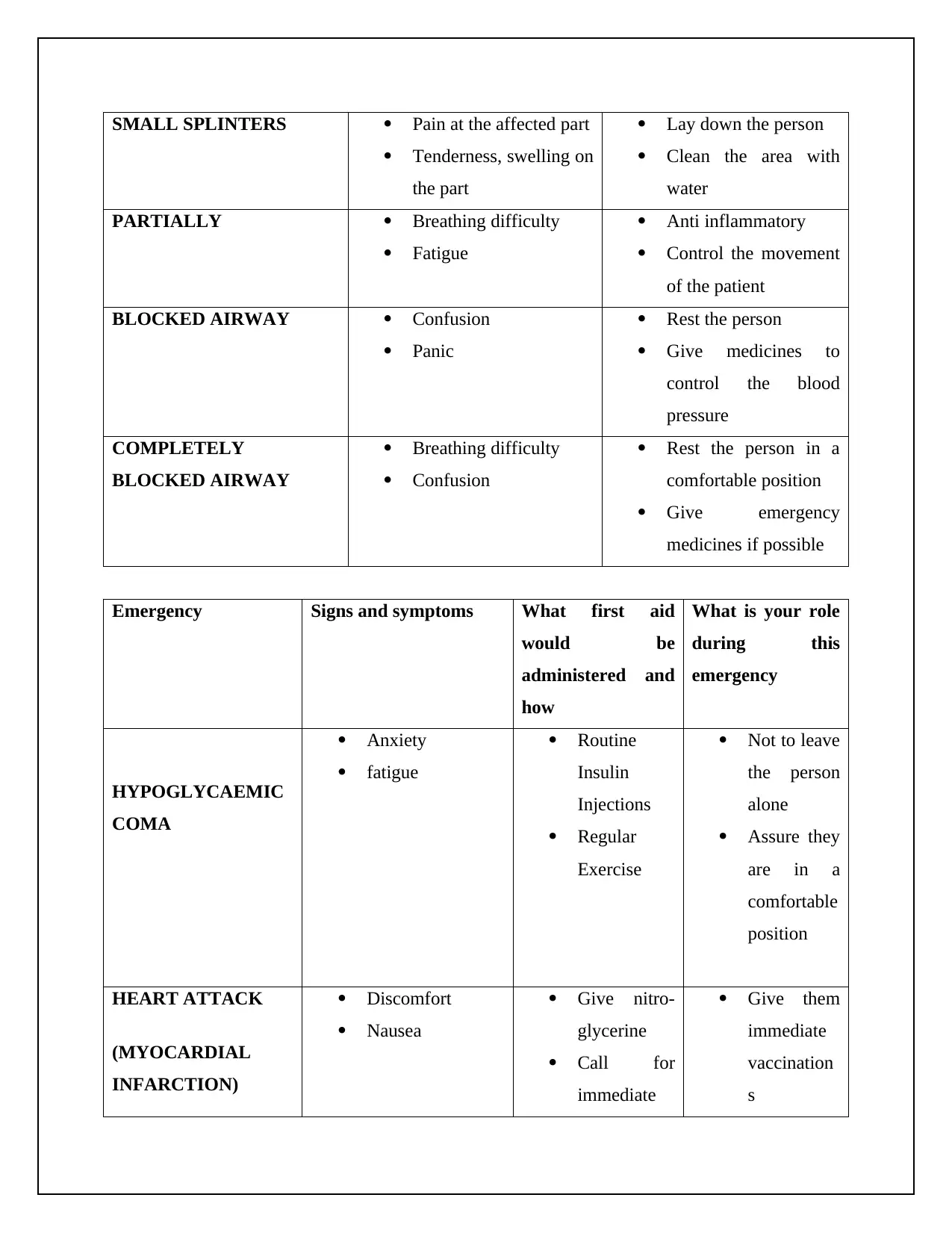
SMALL SPLINTERS Pain at the affected part
Tenderness, swelling on
the part
Lay down the person
Clean the area with
water
PARTIALLY Breathing difficulty
Fatigue
Anti inflammatory
Control the movement
of the patient
BLOCKED AIRWAY Confusion
Panic
Rest the person
Give medicines to
control the blood
pressure
COMPLETELY
BLOCKED AIRWAY
Breathing difficulty
Confusion
Rest the person in a
comfortable position
Give emergency
medicines if possible
Emergency Signs and symptoms What first aid
would be
administered and
how
What is your role
during this
emergency
HYPOGLYCAEMIC
COMA
Anxiety
fatigue
Routine
Insulin
Injections
Regular
Exercise
Not to leave
the person
alone
Assure they
are in a
comfortable
position
HEART ATTACK
(MYOCARDIAL
INFARCTION)
Discomfort
Nausea
Give nitro-
glycerine
Call for
immediate
Give them
immediate
vaccination
s
Tenderness, swelling on
the part
Lay down the person
Clean the area with
water
PARTIALLY Breathing difficulty
Fatigue
Anti inflammatory
Control the movement
of the patient
BLOCKED AIRWAY Confusion
Panic
Rest the person
Give medicines to
control the blood
pressure
COMPLETELY
BLOCKED AIRWAY
Breathing difficulty
Confusion
Rest the person in a
comfortable position
Give emergency
medicines if possible
Emergency Signs and symptoms What first aid
would be
administered and
how
What is your role
during this
emergency
HYPOGLYCAEMIC
COMA
Anxiety
fatigue
Routine
Insulin
Injections
Regular
Exercise
Not to leave
the person
alone
Assure they
are in a
comfortable
position
HEART ATTACK
(MYOCARDIAL
INFARCTION)
Discomfort
Nausea
Give nitro-
glycerine
Call for
immediate
Give them
immediate
vaccination
s
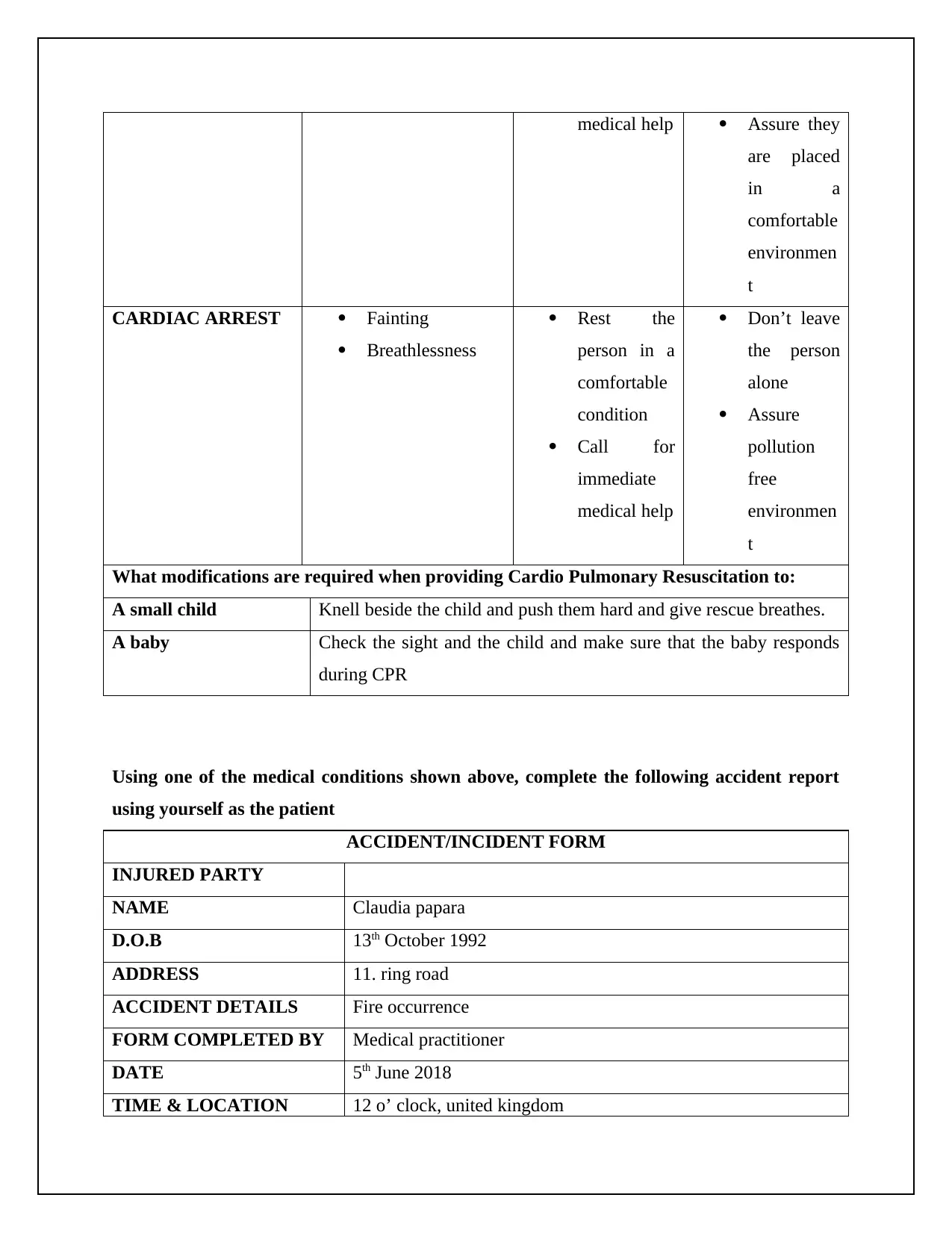
medical help Assure they
are placed
in a
comfortable
environmen
t
CARDIAC ARREST Fainting
Breathlessness
Rest the
person in a
comfortable
condition
Call for
immediate
medical help
Don’t leave
the person
alone
Assure
pollution
free
environmen
t
What modifications are required when providing Cardio Pulmonary Resuscitation to:
A small child Knell beside the child and push them hard and give rescue breathes.
A baby Check the sight and the child and make sure that the baby responds
during CPR
Using one of the medical conditions shown above, complete the following accident report
using yourself as the patient
ACCIDENT/INCIDENT FORM
INJURED PARTY
NAME Claudia papara
D.O.B 13th October 1992
ADDRESS 11. ring road
ACCIDENT DETAILS Fire occurrence
FORM COMPLETED BY Medical practitioner
DATE 5th June 2018
TIME & LOCATION 12 o’ clock, united kingdom
are placed
in a
comfortable
environmen
t
CARDIAC ARREST Fainting
Breathlessness
Rest the
person in a
comfortable
condition
Call for
immediate
medical help
Don’t leave
the person
alone
Assure
pollution
free
environmen
t
What modifications are required when providing Cardio Pulmonary Resuscitation to:
A small child Knell beside the child and push them hard and give rescue breathes.
A baby Check the sight and the child and make sure that the baby responds
during CPR
Using one of the medical conditions shown above, complete the following accident report
using yourself as the patient
ACCIDENT/INCIDENT FORM
INJURED PARTY
NAME Claudia papara
D.O.B 13th October 1992
ADDRESS 11. ring road
ACCIDENT DETAILS Fire occurrence
FORM COMPLETED BY Medical practitioner
DATE 5th June 2018
TIME & LOCATION 12 o’ clock, united kingdom
⊘ This is a preview!⊘
Do you want full access?
Subscribe today to unlock all pages.

Trusted by 1+ million students worldwide
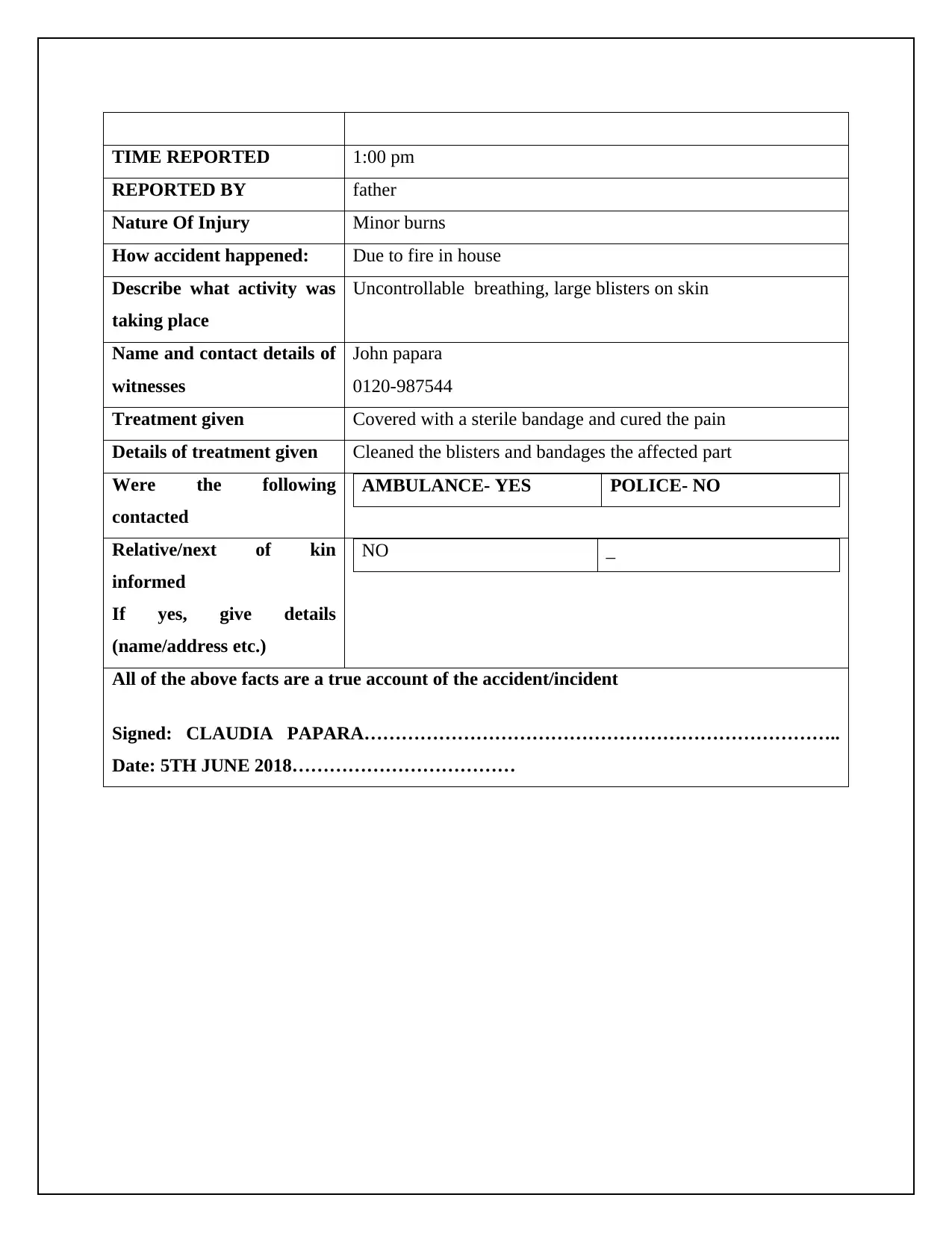
TIME REPORTED 1:00 pm
REPORTED BY father
Nature Of Injury Minor burns
How accident happened: Due to fire in house
Describe what activity was
taking place
Uncontrollable breathing, large blisters on skin
Name and contact details of
witnesses
John papara
0120-987544
Treatment given Covered with a sterile bandage and cured the pain
Details of treatment given Cleaned the blisters and bandages the affected part
Were the following
contacted
AMBULANCE- YES POLICE- NO
Relative/next of kin
informed
If yes, give details
(name/address etc.)
NO _
All of the above facts are a true account of the accident/incident
Signed: CLAUDIA PAPARA…………………………………………………………………..
Date: 5TH JUNE 2018………………………………
REPORTED BY father
Nature Of Injury Minor burns
How accident happened: Due to fire in house
Describe what activity was
taking place
Uncontrollable breathing, large blisters on skin
Name and contact details of
witnesses
John papara
0120-987544
Treatment given Covered with a sterile bandage and cured the pain
Details of treatment given Cleaned the blisters and bandages the affected part
Were the following
contacted
AMBULANCE- YES POLICE- NO
Relative/next of kin
informed
If yes, give details
(name/address etc.)
NO _
All of the above facts are a true account of the accident/incident
Signed: CLAUDIA PAPARA…………………………………………………………………..
Date: 5TH JUNE 2018………………………………
Paraphrase This Document
Need a fresh take? Get an instant paraphrase of this document with our AI Paraphraser
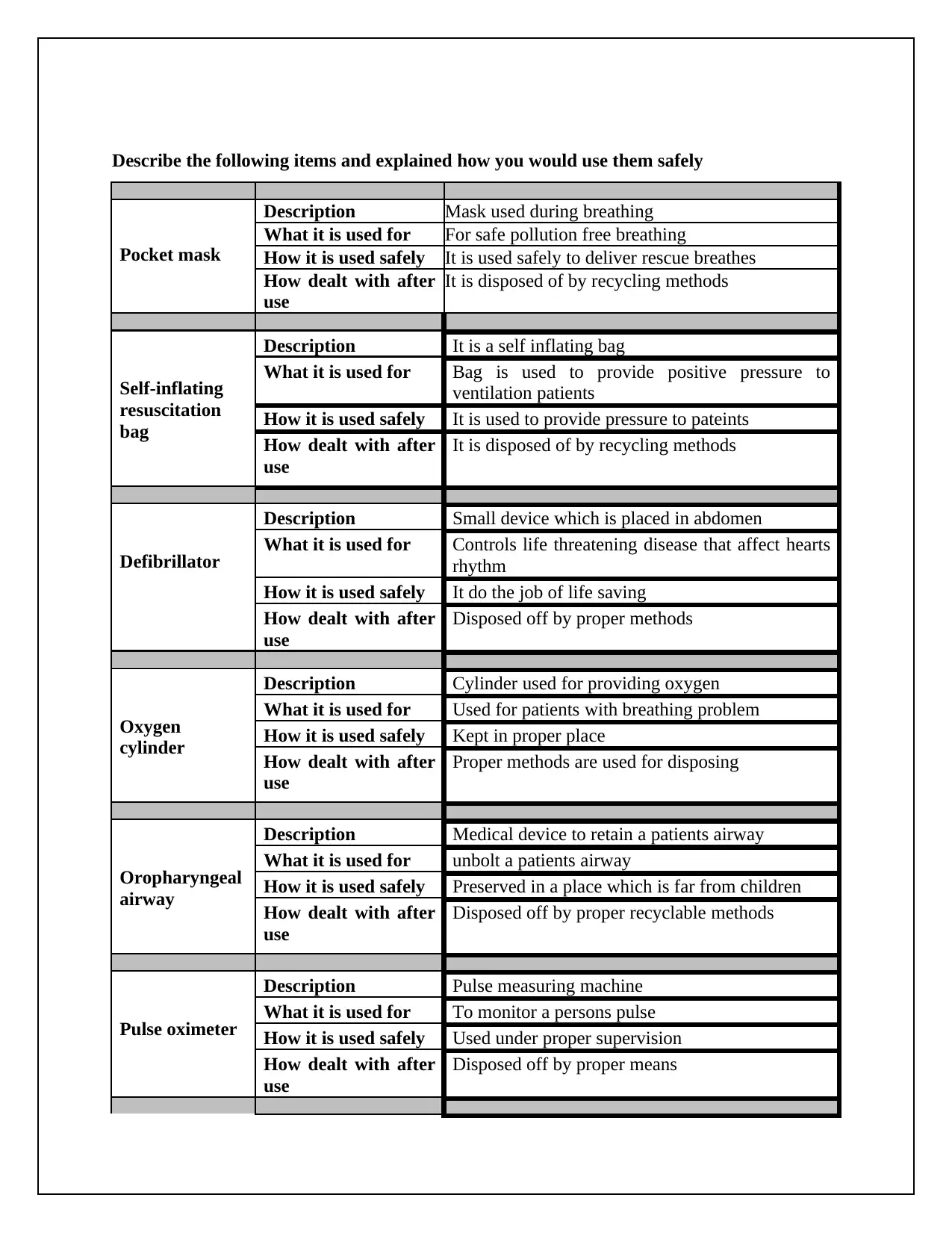
Describe the following items and explained how you would use them safely
Pocket mask
Description Mask used during breathing
What it is used for For safe pollution free breathing
How it is used safely It is used safely to deliver rescue breathes
How dealt with after
use
It is disposed of by recycling methods
Self-inflating
resuscitation
bag
Description It is a self inflating bag
What it is used for Bag is used to provide positive pressure to
ventilation patients
How it is used safely It is used to provide pressure to pateints
How dealt with after
use
It is disposed of by recycling methods
Defibrillator
Description Small device which is placed in abdomen
What it is used for Controls life threatening disease that affect hearts
rhythm
How it is used safely It do the job of life saving
How dealt with after
use
Disposed off by proper methods
Oxygen
cylinder
Description Cylinder used for providing oxygen
What it is used for Used for patients with breathing problem
How it is used safely Kept in proper place
How dealt with after
use
Proper methods are used for disposing
Oropharyngeal
airway
Description Medical device to retain a patients airway
What it is used for unbolt a patients airway
How it is used safely Preserved in a place which is far from children
How dealt with after
use
Disposed off by proper recyclable methods
Pulse oximeter
Description Pulse measuring machine
What it is used for To monitor a persons pulse
How it is used safely Used under proper supervision
How dealt with after
use
Disposed off by proper means
Pocket mask
Description Mask used during breathing
What it is used for For safe pollution free breathing
How it is used safely It is used safely to deliver rescue breathes
How dealt with after
use
It is disposed of by recycling methods
Self-inflating
resuscitation
bag
Description It is a self inflating bag
What it is used for Bag is used to provide positive pressure to
ventilation patients
How it is used safely It is used to provide pressure to pateints
How dealt with after
use
It is disposed of by recycling methods
Defibrillator
Description Small device which is placed in abdomen
What it is used for Controls life threatening disease that affect hearts
rhythm
How it is used safely It do the job of life saving
How dealt with after
use
Disposed off by proper methods
Oxygen
cylinder
Description Cylinder used for providing oxygen
What it is used for Used for patients with breathing problem
How it is used safely Kept in proper place
How dealt with after
use
Proper methods are used for disposing
Oropharyngeal
airway
Description Medical device to retain a patients airway
What it is used for unbolt a patients airway
How it is used safely Preserved in a place which is far from children
How dealt with after
use
Disposed off by proper recyclable methods
Pulse oximeter
Description Pulse measuring machine
What it is used for To monitor a persons pulse
How it is used safely Used under proper supervision
How dealt with after
use
Disposed off by proper means
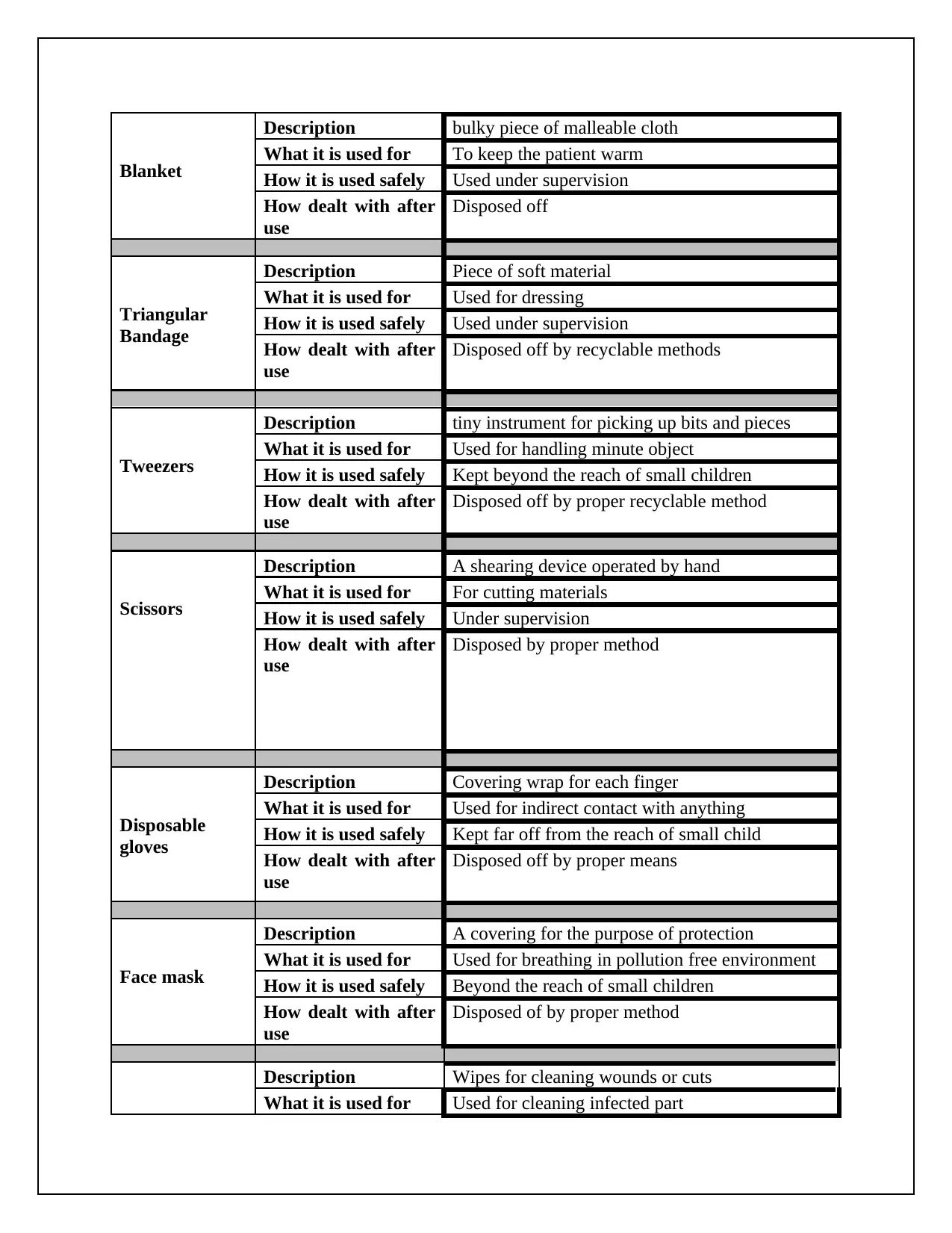
Blanket
Description bulky piece of malleable cloth
What it is used for To keep the patient warm
How it is used safely Used under supervision
How dealt with after
use
Disposed off
Triangular
Bandage
Description Piece of soft material
What it is used for Used for dressing
How it is used safely Used under supervision
How dealt with after
use
Disposed off by recyclable methods
Tweezers
Description tiny instrument for picking up bits and pieces
What it is used for Used for handling minute object
How it is used safely Kept beyond the reach of small children
How dealt with after
use
Disposed off by proper recyclable method
Scissors
Description A shearing device operated by hand
What it is used for For cutting materials
How it is used safely Under supervision
How dealt with after
use
Disposed by proper method
Disposable
gloves
Description Covering wrap for each finger
What it is used for Used for indirect contact with anything
How it is used safely Kept far off from the reach of small child
How dealt with after
use
Disposed off by proper means
Face mask
Description A covering for the purpose of protection
What it is used for Used for breathing in pollution free environment
How it is used safely Beyond the reach of small children
How dealt with after
use
Disposed of by proper method
Description Wipes for cleaning wounds or cuts
What it is used for Used for cleaning infected part
Description bulky piece of malleable cloth
What it is used for To keep the patient warm
How it is used safely Used under supervision
How dealt with after
use
Disposed off
Triangular
Bandage
Description Piece of soft material
What it is used for Used for dressing
How it is used safely Used under supervision
How dealt with after
use
Disposed off by recyclable methods
Tweezers
Description tiny instrument for picking up bits and pieces
What it is used for Used for handling minute object
How it is used safely Kept beyond the reach of small children
How dealt with after
use
Disposed off by proper recyclable method
Scissors
Description A shearing device operated by hand
What it is used for For cutting materials
How it is used safely Under supervision
How dealt with after
use
Disposed by proper method
Disposable
gloves
Description Covering wrap for each finger
What it is used for Used for indirect contact with anything
How it is used safely Kept far off from the reach of small child
How dealt with after
use
Disposed off by proper means
Face mask
Description A covering for the purpose of protection
What it is used for Used for breathing in pollution free environment
How it is used safely Beyond the reach of small children
How dealt with after
use
Disposed of by proper method
Description Wipes for cleaning wounds or cuts
What it is used for Used for cleaning infected part
⊘ This is a preview!⊘
Do you want full access?
Subscribe today to unlock all pages.

Trusted by 1+ million students worldwide
1 out of 17
Related Documents
Your All-in-One AI-Powered Toolkit for Academic Success.
+13062052269
info@desklib.com
Available 24*7 on WhatsApp / Email
![[object Object]](/_next/static/media/star-bottom.7253800d.svg)
Unlock your academic potential
Copyright © 2020–2025 A2Z Services. All Rights Reserved. Developed and managed by ZUCOL.





